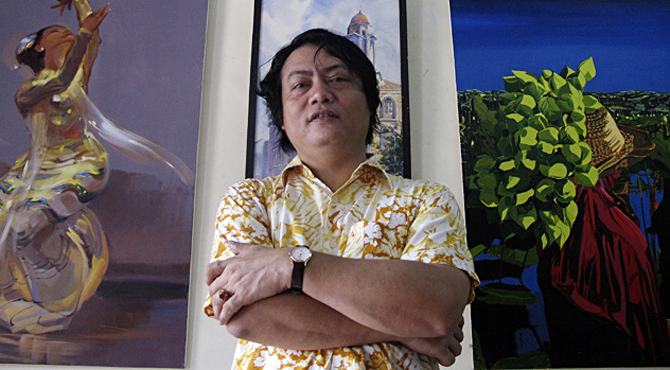Art for Rangoon's Sake

On the first floor of a dilapidated building in downtown Rangoon, a narrow staircase leads up to a small space that probably houses more contemporary art per square meter than anywhere else in the city: the Pansodan Gallery. Unlike other galleries, such as those at Bogyoke Aung San market that only sell paintings with “exotic” themes to satisfy the wildt Orientalist fantasies of tourists, Pansodan reveals an art scene far richer than one would expect in a country like Burma/ Myanmar—mired in poverty, isolated for years from the rest of the world, and tightly controlled by one of the most repressive dictatorships in the world.
In its three years, the gallery, open every day of the week until six in the evening, has become a meeting place for artists and art enthusiasts. Burmese and foreigners all visit the gallery, not only to buy or sell pieces of art, but to have a tea, exchange ideas, attend a poetry reading, or simply to relax for a while. The gallery’s owner, Aung Soe Min, is a gentle and kind man that welcomes visitors with Burmese hospitality, and is always relaxed and happy to answer any questions.
Aung Soe Min was born 41 years ago in a small town in central Burma. Testifying to the country’s isolation, he says he never met a foreigner until he was 25 years old. After studying engineering, he spent several years in the publishing business and began collecting books. Today he owns one of the largest libraries of Burma, which is visited by scholars from around the world.
In the late 1980s, after the collapse of the regime of Gen. Ne Win and his “Burmese Way to Socialism,” there was a slight cultural opening when the military junta that succeeded tried to attract foreign investment. “The country was changing and I tried to take advantage of this to study everything I could,” says Aung Soe Min. He also tried to make films, but he couldn’t always get the necessary permits, which, combined with a lack of official support or distribution, made it a nearly impossible undertaking.
During those years, Aung Soe Min met numerous writers and artists, and seeing that the country lacked the “infrastructure and market necessary for artists to distribute their works,” he decided to open his own gallery in 2005. It took him three years, but in 2008, after overcoming many obstacles and using the profits he made from selling “three especially valuable paintings” he was able to buy a property located in downtown Pansodan Street, close to the old colonial neighbourhood at the heart of the city, and open his gallery.
“At that time there were several galleries in Rangoon, but the majority catered exclusively to foreign clients. Burmese people did not even visit many of these galleries, or if they did it was only when accompanying a foreigner. What I’m trying to do here is create a space that’s open to evrybody,” says Aung Soe Min. His purpose is not only to “sell paintings, but also awaken Burmese people’s interest in the arts. When people say that I promote artists, I say no, I’m promoting a public.”
According to Aung Soe Min, works from some 200 artists are for sale at the Pansodan Gallery, which is not hard to believe since every day new paintings appear on the walls or scattered around the floor. “Artists will often come in and tell me they need money urgently. They bring me a painting, and if I like it I buy it myself and then try to resell it. Most other galleries, on the other hand, usually don’t pay artists until they sell their works,” he explains.
It’s not easy being an artist in Burma. The poverty, the lack of opportunities, and the scarce knowledge or interest in contemporary art make developing an artistic career far more difficult than it is the case of other countries. One of the young artists that displays his work at the Pansodan Gallery, Ein Aye Kyaw, manages to make a hard living painting by commission, especially traditional landscapes. After studying zoology and fine arts at the University of Rangoon, he decided to devote himself professionally to art five years ago when he saw a man painting on his street, he thought that “he’s the only person that really looks tranquil and happy” and that man became his first mentor.
Ein Aye Kyaw’s paintings, in a simple, impressionist style that he polishes in each painting, depict ordinary scenes or images that, as he explains, compel him to paint without really knowing why—an old taxi in the rain, a child playing in a park, or the strange structure of the Arakanese Kingdom, a half-pagoda, half-military fort palace that came to his mind after seeing an official building in Naypyidaw, Burma’s new capital that the military junta built in the middle of the jungle six years ago.
1 | 2 next page »
|
||
|
||
|
||
|
||
- 'My Wife Died From Police Abuse,' Says Husband
- US Says Observer Conditions Don't Meet Int'l Standards
- 159 Observers to Monitor Burma Election
- Govt to Address Breaches of SSA-South Ceasefire: Aung Min
- Burma Investors Pin Hopes on Seminal Sunday
- Malaysia PM Leads 50-Strong Delegation to Burma
- US Congress to Assess Burma's Political Prisoner Issue
- Rangoon Woman in Police Station Death Plunge
- Burmese Legal System Remains Tool of Govt: AHRC
- Burmese Army Chief Defends Political Role
